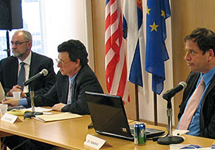William Potter
Miles Pomper
Nikolai Sokov
June 23, 2010
Briefing Event
Sponsored by:
- James Martin Center for Nonproliferation Studies (CNS)
- The Permanent Mission of Finland to the United States
Experts briefed Nonproliferation Treaty (NPT) diplomats, governmental officials, and nongovernmental organizations on the following report. The event was held between sessions of the 2010 nuclear Nonproliferation Treaty Conference.
The New Report

Event Panelists,
Source: Nonproliferation.org
View the full report: Reducing and Regulating Tactical (Nonstrategic) Nuclear Weapons in Europe
Studies & Report sponsored by:
- Unit for Policy Planning and Research of the Finnish Ministry for Foreign Affairs
The report was based on a series of studies examining the recent discussion in the United States, Europe, and Russia over ways to relocate, reduce and eliminate nonstrategic nuclear weapons. Included were weapons that are estimated to remain in Europe 20 years after the Cold War. This updated a report released in December, Reducing and Regulating Tactical (Nonstrategic) Nuclear Weapons in Europe.
The report accounted for:
- The recently signed New START treaty between the United States and Russia
- Russia’s new military doctrine
- The Obama administration’s Nuclear Posture Review
- An informal meeting of NATO foreign ministers in Tallinn, Estonia in late April 2010
Founding Director, Dr. William Potter, placed the current debate in historical context and emphasized the leadership role previously played by Scandinavian states and Germany. He expressed regret that the New Agenda Coalition (NAC) no longer appeared to devote as much priority to the issue and urged NAC members to put forward new proposals. He also suggested that the Review Conference adopt language in its forward-looking component that encourages the nuclear-weapon states to undertake further reductions in non-strategic nuclear weapons on the basis of legally-binding and verifiable agreements.
Senior Research Associate, Miles Pomper, discussed how domestic US political pressures and a desire to maintain NATO cohesion amid differences between Western and Eastern Europe seemed to be converging on a NATO policy that would try to shift the onus for progress to Russia by demanding that Russia carry out reciprocal steps for any NATO actions, such as withdrawing nonstrategic weapons from Europe.
View Miles Pomper’s slide presentation: US Nonstrategic Weapons in Europe: Views in the United States and Europe
Senior Research Associate, Nikolai Sokov, argued that, contrary to common perception, short-range nuclear weapons do not play a significant role in Russian nuclear strategy, but given the domestic political lineup in Russia with regard to these weapons, the NATO lowest common denominator policy would likely lead to a stalemate on the issue, at least in the short to medium term.
View Nikolai Sokov’s slide presentation: Reducing and Regulating Non-Strategic Nuclear Weapons in Europe: The Russian Dimension and Options for Action
Experts noted that one possible solution put forward by US officials—a trade of cuts in US nondeployed warheads for Russian nonstrategic nuclear weapons—might be feasible but would require extensive and groundbreaking negotiations and transparency.
Senior Finnish foreign ministry official, Jaakko Laajava, Finland’s undersecretary of State, concluded the meeting with an emphasis on the importance of the issue to Finland and Scandinavian countries.
